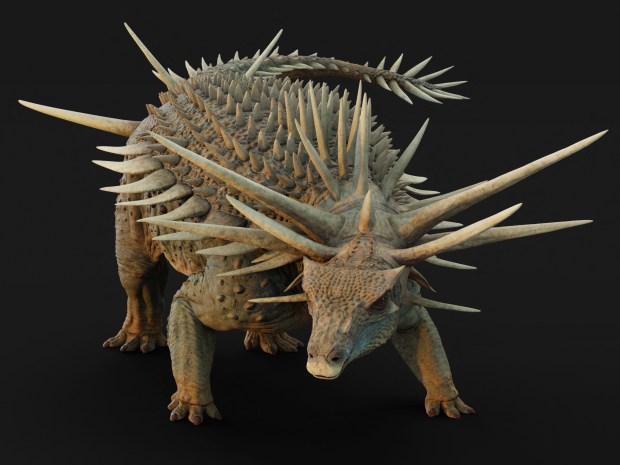Science
Scientists Uncover Unique Spiked Dinosaur Fossil from 165 Million Years Ago

A team of palaeontologists has unveiled an extraordinary discovery in the form of the Spicomellus, a “punk rocker” dinosaur that roamed the Earth approximately 165 million years ago. The analysis of recently uncovered fossils revealed that this ancient creature had distinctive metre-long spikes protruding from its neck, designed as a defensive mechanism against predators. The findings were published in the scientific journal Nature.
The Spicomellus is classified as the world’s oldest known ankylosaur, a group of herbivorous dinosaurs recognized for their heavily armoured bodies and club-like tails. This particular species has been described as one of the “strangest dinosaurs” ever discovered. Newly examined fossils indicate that these spikes, measuring up to 87 centimetres, arose from a bony collar surrounding the neck area. According to researchers, these spikes may have been even longer during the dinosaur’s lifetime.
Professor Richard Butler from the University of Birmingham and co-leader of the study emphasized the significance of this find, stating, “Spicomellus is utterly unlike any other found anywhere else in the world.” He expressed confidence that this discovery would captivate the public and enhance understanding of the early evolution of ankylosaurs.
Another co-leader of the research, Professor Susannah Maidment from the Natural History Museum in London, remarked on the “absolutely bizarre” nature of the fossils. She noted that initial doubts regarding Spicomellus’ classification as an ankylosaur have been definitively resolved. “Africa’s only known ankylosaur is far weirder than anyone imagined,” she added.
The discovery process began in 2019 when Professor Maidment acquired a rib bone from a fossil dealer in Cambridge. This initial find led to further explorations that revealed the comprehensive array of defensive adaptations, including not only neck spikes but also large upward-projecting spikes near the hips and various blade-like spikes across the body.
Researchers believe that while the evolution of these features was likely initiated for protection against predators, they may have later served a role in attracting mates and displaying dominance among rivals.
The Spicomellus discovery sheds light on the diversity of ankylosaurs and their evolutionary strategies, fundamentally enriching our understanding of this unique group of dinosaurs. As researchers continue to study these remarkable fossils, they hope to uncover additional insights into not just the Spicomellus itself, but also the broader evolutionary narrative of armoured dinosaurs.
-

 Entertainment4 weeks ago
Entertainment4 weeks agoAimee Osbourne Joins Family for Emotional Tribute to Ozzy
-

 Politics1 month ago
Politics1 month agoDanny Healy-Rae Considers Complaint After Altercation with Garda
-

 Top Stories2 weeks ago
Top Stories2 weeks agoIreland Enjoys Summer Heat as Hurricane Erin Approaches Atlantic
-

 World1 month ago
World1 month agoHawaii Commemorates 80 Years Since Hiroshima Bombing with Ceremony
-

 Top Stories1 month ago
Top Stories1 month agoFianna Fáil TDs Urgently Consider Maire Geoghegan-Quinn for Presidency
-

 World1 month ago
World1 month agoGaza Aid Distribution Tragedy: 20 Killed Amid Ongoing Violence
-

 World1 month ago
World1 month agoCouple Convicted of Murdering Two-Year-Old Grandson in Wales
-

 Top Stories1 month ago
Top Stories1 month agoClashes Erupt Between Far-Right Groups and Migrants in Spain
-

 World1 month ago
World1 month agoAristocrat Constance Marten and Partner Convicted of Infant Murder
-

 Top Stories1 month ago
Top Stories1 month agoHistoric Dalkey Pub The Queens Reopens Under New Management
-

 World1 month ago
World1 month agoTrump Defends FBI Deputy Director Amid Epstein Files Controversy
-

 Politics1 month ago
Politics1 month agoTragic Crowd Surge at Gaza Aid Center Claims 20 Lives









